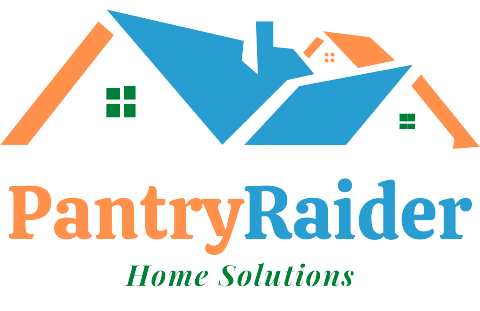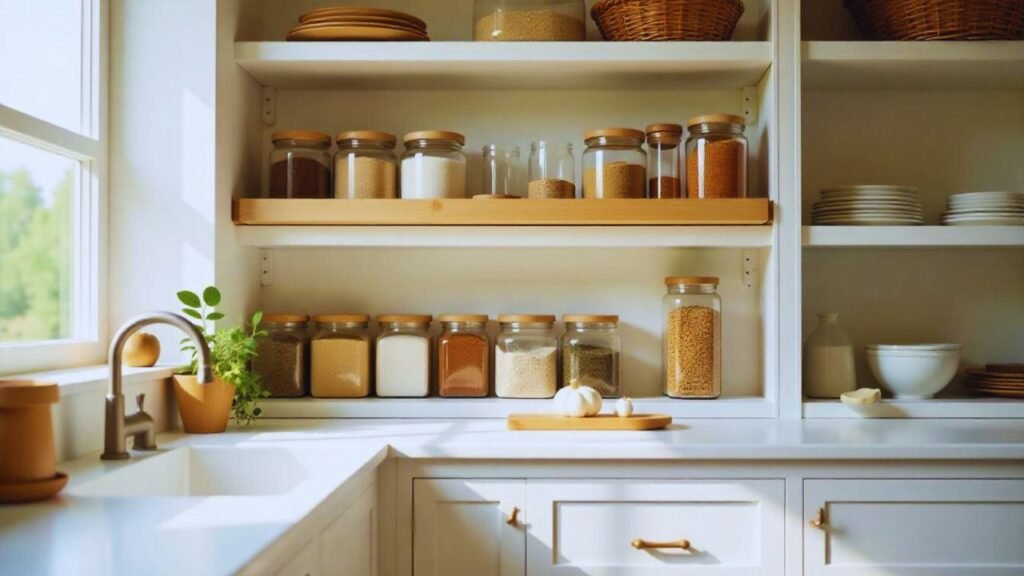
If you’ve ever stood in front of your pantry, perhaps after a minor (or major) spice avalanche or a sticky jam incident, and thought, “There has to be a better way to keep these shelves looking pristine,” you’re in good company. Pantry shelves, much like kitchen cabinets, endure a surprising amount of daily wear and tear. They’re subject to spills, scuffs, and constant reorganizing, making them prime candidates for a refresh that goes beyond just a quick wipe-down. This is where choosing the best paint for pantry shelves becomes not just a decorating choice, but a practical necessity.
Painting your pantry shelves can breathe new life into your kitchen, creating a clean, organized, and inviting space for your culinary treasures. It’s a remarkably economical way to transform the vibe in your home without committing to a full remodel, freeing up funds for other exciting projects. But, much like preparing a gourmet meal, the success of your pantry painting project hinges on selecting the right ingredients – in this case, the perfect paint and meticulous preparation.
So, let’s dive into the fascinating world of paints, demystifying the options available and arming you with the knowledge to pick the best paint for pantry shelves that will stand the test of time, spills, and endless snack raids!
Why Your Pantry Shelves Deserve the Best Paint
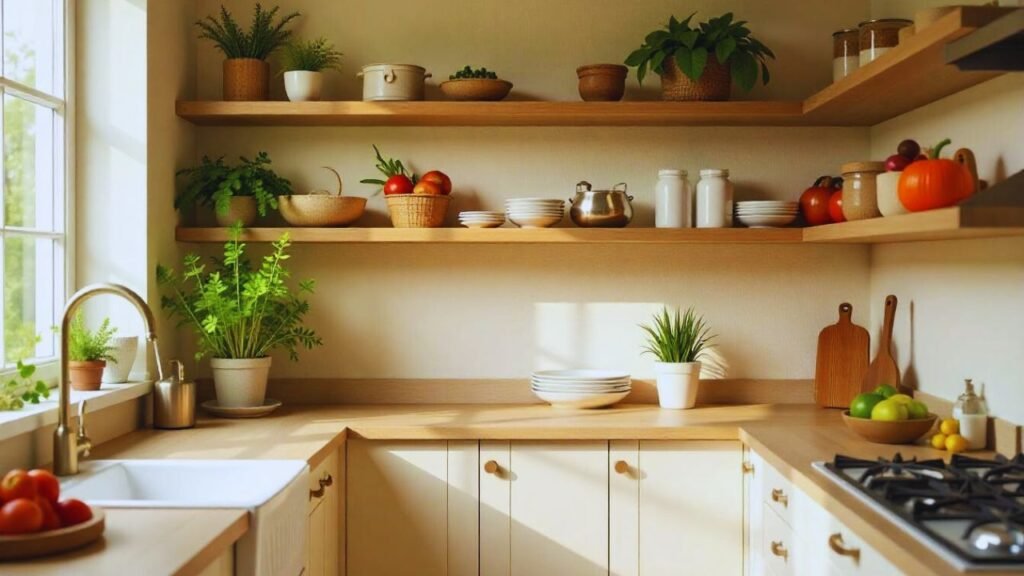
Your pantry shelves are the silent workhorses of your kitchen. They hold everything from weighty canned goods and bulky cereal boxes to delicate spice jars and sticky condiments. Given this demanding role, it’s not just about aesthetics; it’s about choosing a paint that can truly perform. You need a finish that’s not only beautiful but also incredibly durable, easy to clean, and resistant to the daily onslaught of kitchen life.
Think about it: how many times do you slide a heavy bag of flour across a shelf, or accidentally knock a bottle of olive oil? These shelves need to withstand constant friction, impact, and the inevitable spills that come with food storage. A standard wall paint simply won’t cut it. It will scratch, scuff, and likely show every smudge, turning your beautifully refreshed pantry into a regrettable mess in no time. That’s why understanding the characteristics that make up the best paint for pantry shelves is crucial.
Understanding Paint Types: Water-Based vs. Oil-Based vs. Hybrids
Before we get to specific recommendations for the best paint for pantry shelves, it’s essential to understand the fundamental differences in paint formulations. This knowledge will empower you to make an informed decision tailored to the unique demands of your pantry. The main contenders are water-based (acrylic/latex), oil-based, and a newer category known as hybrid alkyd enamels.
Water-Based (Acrylic/Latex) Paints: The Modern Marvels
For many years, oil-based paints were the undisputed champions of durability, especially for high-traffic surfaces. However, water-based paints have come a tremendously long way. Modern formulations have significantly improved, offering durability and performance that make them a viable option for many home interior projects, including certain high-touch surfaces.
What they are: Water-based paints use water as their primary solvent, making them easier to work with and clean up. They are also commonly referred to as acrylic or latex paints.
Pros:
- Fast Drying: This is a huge advantage! If you’re eager to get your pantry back in action, water-based paints dry much quicker, often allowing for multiple coats in a single day. For example, BEHR Marquee Advanced Stain-Blocking Paint & Primer boasts a one-hour drying time.
- Low Odor & Low VOCs: Historically, paint fumes were a major concern. Water-based paints, especially those explicitly labeled “low VOC” or “zero VOC,” emit significantly fewer harmful chemical compounds, making them safer for indoor use and better for your health. HGTV HOME by Sherwin-Williams Ovation Plus, for instance, claims to eliminate VOCs, delivering lower odor without compromising durability. Similarly, Behr Premium Plus is Greenguard Gold Certified for low odor and emissions.
- Easy Clean-Up: Spills on paintbrushes or surfaces can often be cleaned with just soap and water, eliminating the need for harsh chemical solvents like turpentine or mineral spirits.
- Color Variety: Good quality latex paints are available in a vast array of colors. Behr Marquee, for example, comes in over 1,000 hues.
Cons:
- Potentially Less Durable (Historically): While modern water-based paints have improved, some general variants might still be less durable on extremely high-contact surfaces compared to oil-based or hybrid options.
- May Show Brush Marks: Unless applied with meticulous care or a high-quality roller, some water-based paints might reveal brush marks more readily.
- Can Raise Wood Grain: If used on raw MDF, water-based primers or paints can cause the wood grain to swell, leading to a rough finish that is difficult to sand smooth.
Best Use Cases for Pantry Shelves: High-quality acrylic paints are suitable for pantry shelves, particularly if they are specially formulated for cabinets or high-traffic areas. For example, Tikkurila Helmi 10 and Helmi 30 are advanced water-based acrylic paints suitable for kitchen cabinets, skirtings, and furniture in high-traffic areas. HGTV HOME by Sherwin-Williams Infinity is a good latex option that offers superb stain resistance and cleanability, making it well-suited for kitchen cabinets.
Oil-Based Paints: The Traditional Tough Guy
Oil-based paints have long been celebrated for their robustness and smooth finish, especially on woodwork and high-wear areas.
What they are: These paints use mineral spirits or turpentine as their solvent.
Pros:
- Superior Durability and Hardness: They dry to an exceptionally hard, durable, and scratch-resistant finish that can withstand significant wear and tear. This makes them ideal for surfaces that get “knocked around” a lot.
- Smoother Finish: Oil-based paints tend to level out better as they dry, minimizing brushstrokes and resulting in a very smooth, furniture-grade finish.
- Excellent Adhesion and Stain Blocking: They adhere exceptionally well, even to tricky surfaces, and are excellent at sealing in stains, including tannins from wood, preventing them from bleeding through the topcoat.
Cons:
- Strong Odor & Higher VOCs: This is the most significant drawback. Oil-based paints release a strong odor and higher levels of volatile organic compounds (VOCs), requiring excellent ventilation during and after application. Chronic exposure to high VOCs can lead to health issues.
- Longer Dry Time: They take much longer to dry, typically 6-24 hours between coats, which can extend project timelines significantly.
- Needs Solvents for Clean-Up: Cleaning brushes and spills requires mineral spirits or turpentine, which are more inconvenient and harsh than soap and water.
- Can Yellow Over Time: Some oil-based gloss paints can yellow over the years, especially in areas not exposed to UV light, like inside a closet or pantry.
Best Use Cases for Pantry Shelves: Due to their superior durability and smooth finish, traditional oil-based paints are excellent for pantry shelves, especially if you prioritize maximum toughness and don’t mind the longer drying times and cleanup. However, the VOCs and odor might be a deterrent for indoor use in enclosed spaces like a pantry.
Hybrid Alkyd Enamel Paints: The Best of Both Worlds
This newer category of paint is gaining popularity, especially among professionals, because it attempts to combine the advantages of both water-based and oil-based formulations.
What they are: Often called “waterborne alkyds,” these paints are formulated with an alkyd resin (like oil paints) but use water as their primary solvent, or a hybrid of both.
Pros:
- Durability and Hard Finish: They cure to an exceptionally hard, durable, furniture-grade finish, much like traditional oil-based paints, capable of standing up to busy kitchens and high-touch surfaces.
- Excellent Flow and Leveling: This means they apply smoothly and self-level, minimizing brush marks and streaks, resulting in a professional-looking finish.
- Water Clean-Up: Despite their oil-like properties, brushes and spills can often be cleaned with plain water, eliminating the need for harsh solvents.
- Lower VOCs (Compared to Oil-Based): While they might still have some VOCs, they are generally lower than traditional oil-based paints.
Cons:
- Pricey: Hybrid paints tend to be more expensive than standard latex paints, sometimes costing upwards of $100 per gallon.
- Availability: Some specialty hybrid finishes might need to be ordered in advance and may not be as widely available as standard formulas.
Best Use Cases for Pantry Shelves: Hybrid alkyd enamels are arguably the best paint for pantry shelves if you’re seeking top-tier durability and a smooth finish with the convenience of water-based cleanup. Benjamin Moore Advance is highlighted as a prime example, formulated specifically for kitchen cabinets and other high-touch surfaces. BEHR Urethane Alkyd Semi-Gloss Enamel is another superb value option in this category.
Key Features to Look for in the Best Paint for Pantry Shelves
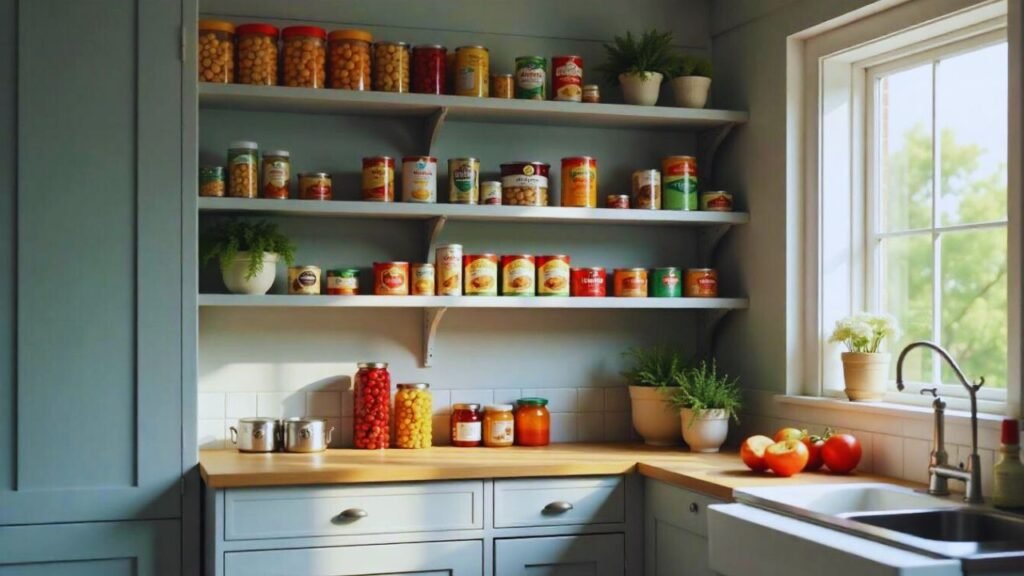
When selecting the ideal paint for your pantry shelves, keep these critical characteristics in mind to ensure a long-lasting and easy-to-maintain finish.
Durability: Withstanding the Daily Grind
Pantry shelves are subjected to constant friction, impacts, and the weight of various items. Therefore, durability is paramount. You need a paint that can resist scuffs, abrasions, and chipping. Good Housekeeping Institute experts rigorously test paints for durability, including using an abrasion machine that simulates years of scrubbing and scratching with fine-grit sandpaper. Paints that deliver a “hard, durable finish” are ideal.
Cleanability: The Stain-Fighting Champion
Let’s face it, messes happen, especially in a pantry. Flour dust, sticky spills, and food splatters are inevitable. The best paint for pantry shelves should be easy to clean without damaging the finish or color. This means looking for paints that are highly scrubbable and stain-resistant. Good Housekeeping tests paints by applying tough stains like oil, tomato sauce, and crayon, then attempting to remove them with an all-purpose cleaner. Paints like HGTV HOME by Sherwin-Williams Infinity offer superb stain resistance and cleanability.
Low or Zero VOCs: For a Healthier Home
Volatile Organic Compounds (VOCs) are chemicals found in many home products, including paints. Short-term exposure can cause headaches or itchy eyes, while chronic exposure may lead to more serious health issues. For indoor spaces, especially one where food is stored, choosing paints with low or zero VOCs is a smart move for your family’s health. Look for certifications like Greenguard Gold, which indicates third-party testing for low chemical emissions. Benjamin Moore Advance, despite offering 3,500+ colors, still qualifies as a low-VOC formula even after tinting.
The Right Finish: Semi-Gloss is Your Best Friend
The finish of your paint (how shiny or matte it appears) dramatically impacts both aesthetics and functionality. For pantry shelves, experts highly recommend a semi-gloss finish.
Why Semi-Gloss?
- Durability and Hard Coating: Semi-gloss provides a hard, durable coating that stands up well to staining, fading, and chipping.
- Easy to Clean: Its shine makes it exceptionally easy to sponge-clean without the risk of dulling the finish. Dirt and stains are repelled more effectively.
- Reflects Light: In often dimly lit pantries, semi-gloss can help brighten the space by reflecting light.
- Appearance: It creates a clean and polished look.
Alternatives and Considerations:
- Gloss: While the most durable, a full gloss finish can look “a bit shiny and artificial” to some and will highlight every single surface imperfection.
- Satin/Eggshell: These finishes offer good durability and are easier to clean than flat paints, but semi-gloss generally offers superior performance for high-traffic areas like shelves. Some experts recommend satin for woodwork. Tikkurila Helmi 30 is a “semi-matt” finish that provides excellent longevity and can be washed/scrubbed clean.
- Flat/Matte: These finishes are generally not recommended for pantry shelves due to their poor cleanability and lack of durability against scrubbing and scuffs. However, some specialty matte finishes like Crown’s Easyclean® Kitchen Matt Emulsion are formulated with Greaseguard+ Technology to be moisture and stain resistant, suitable for kitchen walls and potentially low-traffic shelves.
An expert from MyJobQuote highlights that semi-gloss paint is “commonly used on trim and molding, as it creates a clean and polished look that contrasts nicely with the flat or eggshell finish of the walls” and is a “good choice for kitchens and bathrooms, as these areas tend to be high-traffic and require frequent cleaning”. They also note its suitability for “doors and cabinets” due to its durable and easy-to-clean surface.
The Foundation of Success: Preparing Your Pantry Shelves for Paint
Imagine building a magnificent sandcastle on a wobbly base. It won’t last, right? The same principle applies to painting. No matter how fantastic the paint is, if your prep work isn’t top-notch, your results will be disappointing. Professionals will tell you that prep work is the most crucial and time-consuming step of any paint job. For the best paint for pantry shelves to perform its magic, proper surface preparation is critical for a durable, long-term finish.
Step 1: Empty and Disassemble (If Possible)
First things first, clear out everything from your pantry. This might sound obvious, but it’s amazing how many people try to paint around items. Remove all shelves, drawers, and existing hardware like hinges, knobs, and pulls. If your drawer fronts are removable, take them off for easier painting; if not, consider covering the drawer boxes with plastic trash bags. Labeling everything will save you a headache during reassembly.
Step 2: The Deep Clean: Banishing Grime and Grease
Pantry shelves, especially in a kitchen, are magnets for grease, food residue, and dust. Paint absolutely will not stick to a dirty surface. This is where a thorough cleaning comes in.
- Degreaser is Your Friend: Start with a heavy-duty degreaser like trisodium phosphate (TSP) to remove all oils and grease. Alternatively, products like Krud Kutter are excellent for thoroughly cleaning all surfaces that need painting.
- Wipe Down Everything: Wipe down all trim, woodwork, and cabinet boxes to ensure they are clear of dust and debris.
Step 3: Sanding (or Deglossing): Creating Grip for the Primer
The purpose of sanding is to “scuff up” the existing finish, creating a rough surface for the primer and paint to adhere to. While some DIYers might be tempted to skip this step (and I get that sentiment – the thought of sanding alllllll those shelves can be unappealing!), It’s generally recommended for the best adhesion.
- Light Sanding: Lightly sand every surface, working your way from medium- to fine-grained sandpaper. For a smooth surface, a 220-grit sandpaper is often recommended.
- Liquid Sander/Deglosser: For the “lazy sander” (and trust me, there’s no shame in that!), a liquid sander or de-glosser can be used instead of traditional sanding. Rust-Oleum, for example, states “excellent adhesion to glossy surfaces without scuff sanding” for some products.
- Remove Dust: After sanding, it’s critical to remove all dust and debris using a microfiber cloth or a tack cloth before applying primer. Vacuuming the boxes first can help remove excessive dust.
Step 4: Patching and Repairs
Now is the time to address any imperfections. If you have screw holes from old hardware, dings, or scrapes, fill them now and sand them smooth before priming.
Step 5: Priming: The Adhesive Layer
Priming is not optional for most pantry shelf projects; it’s “the glue layer that connects your paint to your cabinet door”. Primer preps the surface to accept the paint, ensuring strong adhesion and durability. It also provides a better base for the paint to stick to. For the best paint for pantry shelves to truly last, priming is paramount.
What Type of Primer? Oil-Based for the Win!
- Oil-based primers are widely considered the best primers for kitchen cabinets and pantry shelves, especially if they have a smooth, previously painted, or lacquered finish that is difficult for paint to adhere to.
- Zinsser BIN Shellac-Based Primer is highly recommended by experts for its superior adhesion, smooth finish, and fast dry time. It’s effective at sealing and covering stains, including tannins that can bleed through from wood, particularly important for knotty wood or oak.
- While Zinsser BIN has a strong odor and is not low-VOC, its benefits for adhesion and stain blocking often outweigh these drawbacks for cabinet projects. Remember to use it in a well-ventilated area and consider wearing a respirator.
- Why not water-based primer for cabinets? From experience, water-based primers don’t work as well on laminate or previously finished surfaces; the paint can scratch off. They can also cause raw MDF to swell and raise its grain.
Application:
- Primer can be applied with a roller and brush, or sprayed. If using a roller, choose a rigid one, as some primers are quite liquid and can be repelled initially by the surface.
- Apply a thin coat to avoid drips, especially with watery primers like Zinsser BIN.
- Allow the first coat to dry. For Zinsser BIN, it dries incredibly fast, often allowing you to handle the first door before the last is finished.
- Second Coat of Primer? While one coat is often sufficient, a second coat can be beneficial, especially for raw wood or if the first coat isn’t perfectly consistent. Some DIYers who painted raw wood cabinets used two coats of primer.
- Sanding Between Primer Coats: Lightly sand the primed surface with high-grit sandpaper (e.g., 220-grit or finer) once dry. This step is crucial for achieving a super smooth, professional finish by eliminating drips and brush marks. Wipe away all dust with a tack cloth before proceeding.
Step 6: The Painting Phase
Now for the fun part – applying your chosen best paint for pantry shelves!
Application Method:
- Spraying is often recommended for the smoothest, most professional finish on cabinets and shelves, as it minimizes brush strokes. An electric paint sprayer can yield much better results than a brush.
- Rolling and Brushing are also viable, especially for primer, or if you don’t have a sprayer. However, be mindful of brush marks, especially with water-based paints.
Number of Coats: Most projects benefit from two coats of paint for optimal coverage and durability, especially for high-touch surfaces like cabinets.
Sanding Between Paint Coats: Just like with primer, sanding lightly between paint coats (e.g., with 220-grit or finer sandpaper) is crucial to minimize imperfections, settle dust, and achieve the smoothest possible finish. Always wipe away sanding dust before applying the next coat.
Cure Time: This is often overlooked but incredibly important! Paint and primer need time, not just to dry but to fully cure and harden. Enamel paints, for instance, will continue to harden over weeks or even months. Benjamin Moore Advance requires a minimum of 16 hours between coats and takes weeks to months to fully cure. Allowing ample cure time significantly contributes to the paint’s final durability and resistance to nicks and scuffs. If you rush this, your beautiful new paint job might peel or stick.
Top Paint Recommendations for Pantry Shelves
Based on expert testing and performance, here are some of the standout paints that could be the best paint for pantry shelves, covering various budgets and formulations.
1. Benjamin Moore Advance: Best Overall Cabinet Paint
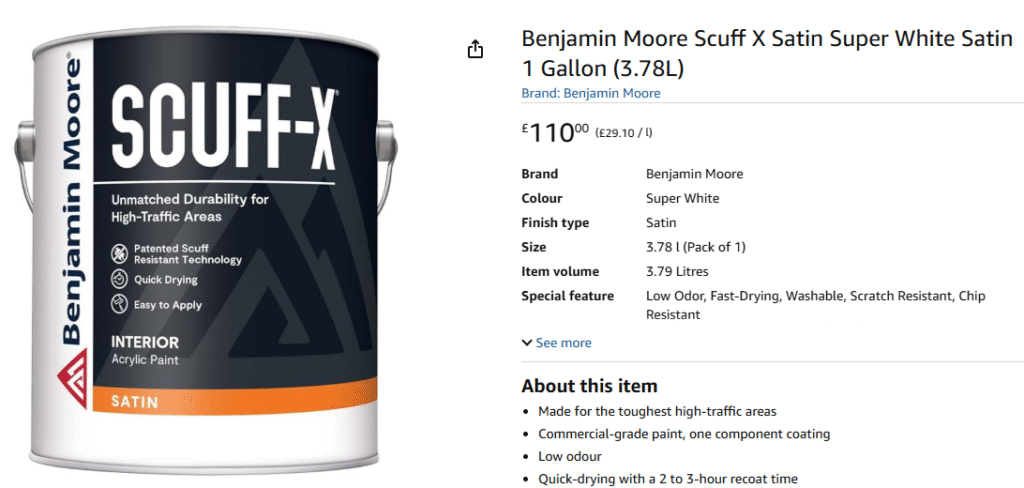
Type: Hybrid alkyd enamel.
Why it’s great for pantry shelves:
- Smooth Application: Favored by professional painters and experts at the Good Housekeeping Institute for its smooth, easy application. Its excellent flow and leveling properties help prevent brush marks.
- Extremely Durable: Cures to an exceptionally hard, furniture-grade finish that can stand up to the busiest kitchens. This makes it ideal for the constant use of pantry shelves endure.
- Low-VOC: Despite offering over 3,500 colors, it remains a low-VOC formula, making it a healthier choice for indoor use.
- Water Clean-Up: Cleans off easily with water, a convenience usually associated with latex paints.
Considerations: It’s a premium product, meaning it’s pricey, and might be harder to find than other options. One user notes it can yellow without UV exposure, so if your pantry is very dark, this might be a consideration.
Credibility: Recommended by Good Housekeeping Institute experts as “Best Overall Cabinet Paint”.
2. BEHR Urethane Alkyd Semi-Gloss Enamel: Best Value Cabinet Paint
Type: Hybrid urethane alkyd semi-gloss enamel.
Why it’s great for pantry shelves:
- Superb Value: Offers comparable quality to more expensive hybrid paints at a more affordable price point.
- Durable Finish: Dries to a hard, durable finish, providing the resilience needed for pantry shelves.
- Excellent Flow and Leveling: Ensures your cabinets won’t be marred by brush marks.
- Easy Clean-Up: Paintbrushes and spills clean easily with plain water.
Considerations: Being a specialty finish, it might require ordering ahead from Home Depot.
Credibility: Selected as “Best Value Cabinet Paint” by Good Housekeeping Institute experts.
3. HGTV HOME by Sherwin-Williams Infinity: Best Latex Cabinet Paint
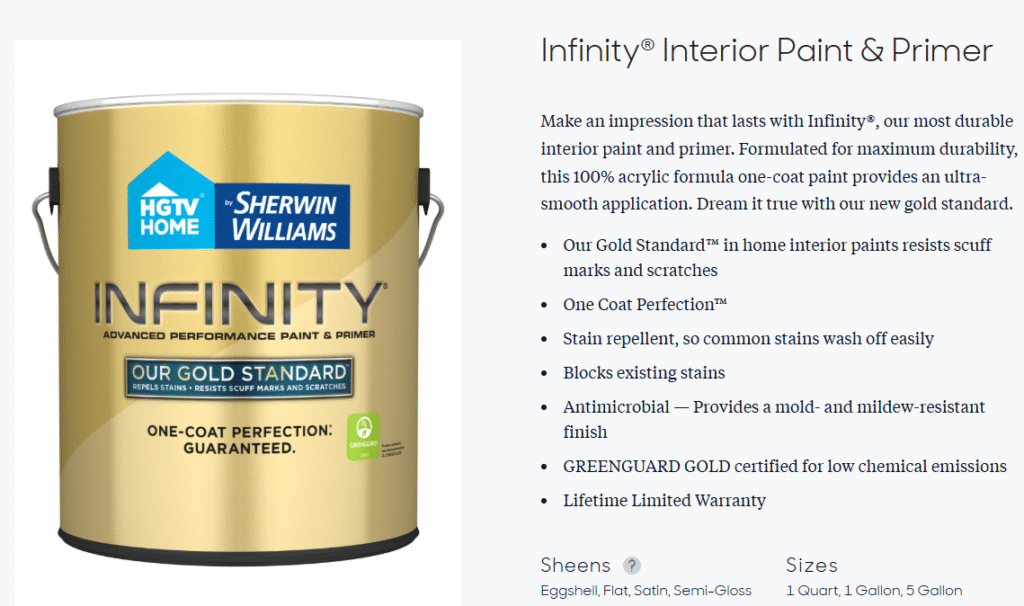
Type: Latex semi-gloss formula.
Why it’s great for pantry shelves:
- Superb Stain Resistance and Cleanability: Its semi-gloss formula is particularly well-suited to kitchen cabinets due to these properties. This is a critical feature for pantry shelves that see food spills.
- Excellent Coverage: Features a self-priming capability, which adds to its excellent coverage, often in a single coat (though two coats are always recommended for cabinets).
- Good Value: Falls in the middle of the price range while delivering exceptional results, avoiding the pitfalls of cheap paints or overpriced, underperforming designer options.
Considerations: Priming is still strongly recommended, even with self-priming features, especially if covering dark surfaces.
Credibility: Recognized for “Excellent for covering dark surfaces” and “Superb stain resistance”.
4. BEHR Marquee Advanced Stain-Blocking Paint & Primer: Best All-Purpose Cabinet Paint
Type: All-around enamel paint with built-in primer.
Why it’s great for pantry shelves:
- Durable, Even Finish: Delivers a smooth, even finish.
- Fast Drying Time: A one-hour drying time is a significant advantage for quick projects.
- One-Coat Coverage with Primer: The built-in primer saves time and material costs, though two coats are often beneficial for pantry shelves.
- Highly Stain and Abrasion Resistant: Proven to be highly resistant to stains and abrasions (scuffs or scouring pads).
Considerations: It’s on the pricier side, but the one-coat coverage can offset material and time costs.
Credibility: Impressed Good Housekeeping Lab testers with its performance as an “extremely well-balanced paint formulated to handle a range of interior projects”.
5. BEHR Premium Plus: Most Durable Cabinet Paint (Value Option)
Type: Enamel paint.
Why it’s great for pantry shelves:
- Excellent Value for Durability: Costs half as much as other top picks but still delivers above-average coverage and can handle abrasive cleaning (scrubber side of a kitchen sponge). This makes it a great choice if you’re looking for the best paint for pantry shelves on a budget without sacrificing too much durability.
- Low Odor and Emissions: Greenguard Gold Certified, meaning it’s been third-party tested for low odor and emissions, contributing to a healthier indoor environment.
Considerations: Stain resistance was more “middling” in tests compared to some other options.
Credibility: Recommended by experts for homeowners on a tight budget needing durable cabinets, and rated highly by consumers for style and appearance.
6. HGTV HOME by Sherwin-Williams Ovation Plus: Best Low-VOC Cabinet Paint
Type: Latex-based paint.
Why it’s great for pantry shelves:
- Low Odor/Zero VOC Claim: Claims to eliminate VOCs, delivering lower odor without compromising durability or hiding capability. This is a strong selling point for pantries, which are enclosed spaces.
- Solid Hiding: Offers good coverage.
- Competitive Price: Appreciated if you have a lot of cabinets or shelves to refinish.
Considerations: Not as stain-resistant as other options on the list.
Credibility: Recognized for its low odor and durability claims, and a competitive price tag.
7. Valspar Reserve: Best Cabinet Paint Sold at Lowe’s
Type: Latex Reserve paint.
Why it’s great for pantry shelves:
- Excellent Coverage and Stain Resistance: Experts praise its coverage and ability to resist stains.
- Resistance to Fading: A nice feature if your pantry has any natural sunlight exposure, preventing colors from dulling over time.
- Lowe’s House Brand: Convenient if Lowe’s is your preferred home center.
Considerations: Pricier than other Valspar products.
Credibility: Recommended by experts for its performance, and it offers a helpful online paint calculator.
8. Glidden High Endurance Plus: Highest Coverage Cabinet Paint (Value Option)
Type: Acrylic paint.
Why it’s great for pantry shelves:
- Great Value and Solid Coverage: Competitively priced and “punches above its weight when it comes to hiding and coverage,” especially with a separate primer. A good choice for budget-conscious renovators looking for the best paint for pantry shelves that still offers good coverage.
Considerations: While the base paint is zero-VOC, the VOC count can rise depending on the chosen color tint (some tints are more chemical-heavy). It might be better for less frequently used areas if chemical content is a top concern.
Credibility: Identified as a “solid option for budget remodelers”.
9. David Kaufman Color DKC: Best Luxury Cabinet Paint
Type: Semi-gloss paint with proprietary pigment combinations.
Why it’s great for pantry shelves:
- Curated Colors: Favored by designers and architects for its unique, curated color palettes, offering a distinct aesthetic beyond mainstream options.
- Durable Finish: Held up extremely well in field tests on cabinets in busy kitchen settings.
- Scrub and Stain Resistant: The hard finish resists scrubbing and stains, with little fading even under intense sunlight.
Considerations: Very expensive, reflecting its luxury status.
Credibility: Good Housekeeping Home Improvement Director Dan Diclerico confirmed its performance in field tests.
10. Clare Interior Paint: Best Boutique Cabinet Paint Brand
Type: Paint delivered direct-to-consumer.
Why it’s great for pantry shelves:
- Curated Color Palettes: Offers a “well-curated selection, including a thoughtful array of trendy picks as well as classic shades,” simplifying color choice.
- Excellent Coverage and Durable Finish: Provided excellent coverage and a smooth, durable finish in tests that should hold up well on kitchen cabinets.
- Low Emissions: Greenguard Gold certified, meeting rigorous emissions standards.
- Convenient Samples: Offers user-friendly peel-and-stick swatches, a cleaner alternative to sample jars.
Considerations: Premium pricing.
Credibility: Winner of Good Housekeeping’s 2023 Home Reno Award and praised by GH Home Design Director Monique Valeris.
Specific Considerations for the Best Paint for Pantry Shelves
Let’s delve into some common questions and scenarios you might encounter when tackling your pantry.
Best Paint Finish for Pantry Shelves
As mentioned earlier, a semi-gloss finish is overwhelmingly recommended for pantry shelves. Its durability, resistance to stains, and ease of cleaning make it the practical choice for a high-use area where items are constantly being moved and spills are a regular occurrence. While a full gloss is the most durable, its tendency to highlight imperfections and intense shine can be off-putting for some. Matte or flat finishes are generally a no-go for pantry shelves due to their poor scrubbability and tendency to show marks.
Best Paint for Wood Pantry Shelves
If your pantry shelves are made of raw wood, you have a solid foundation for painting. The key here is effective priming to prevent issues like tannin bleed-through and to ensure excellent adhesion.
- Primer is Essential: An oil-based primer, particularly Zinsser BIN Shellac-Based Primer, is highly recommended for wood surfaces, especially oak or knotty wood, to prevent naturally occurring tannins from seeping through your paint and ruining the finish. Raw MDF (Medium-Density Fiberboard), often used for shelves, will also benefit greatly from an oil-based primer, as water-based primers can cause its grain to raise, resulting in a rough texture.
- Paint Type: Once primed, you can use a high-quality water-based enamel or a hybrid alkyd enamel. Benjamin Moore Advance is an excellent choice due to its durability and smooth finish. BEHR Urethane Alkyd Semi-Gloss Enamel also offers a durable finish for wood. For a more traditional approach, oil-based paints are also extremely hard-wearing on wood. Crown Paints offers “Wood & MDF Primer & Undercoat” that is quick-drying (touch dry in 1 hour) and specifically designed to prepare bare wood and MDF.
Best Paint for Laminate Pantry Shelves
Many modern pantry shelves, or even older IKEA pieces, might be made of laminate or particleboard with a laminate finish. Painting laminate can be tricky because it’s a shiny, slick surface that paint struggles to adhere to.
- Primer is the Hero: The absolute key to successfully painting laminate is using the right primer. A shellac-based primer, such as Zinsser BIN Shellac-Based Primer, is strongly recommended as the best paint for pantry shelves made of laminate because it creates the necessary bond between the slippery laminate and the paint without requiring sanding.
- Paint Type: After priming, you can top it with a durable latex house paint or an oil-based paint for increased durability. A urethane alkyd enamel is also an excellent choice for laminate due to its strong adhesion and durable finish.
- Preparation: While the shellac-based primer reduces the need for sanding, thoroughly cleaning the laminate surface with a degreaser is still crucial before priming.
Best Paint for Kitchen Pantry Shelves (General)
When we talk about the best paint for kitchen pantry shelves, we’re essentially looking at the same qualities as the best kitchen cabinet paints. Both areas experience high traffic, spills, and need to be easy to clean.
- Hybrid Alkyd Enamels: These are consistently top-rated for kitchen cabinets and, by extension, pantry shelves. They offer the durability of oil-based paints with easier water cleanup. Benjamin Moore Advance and BEHR Urethane Alkyd Semi-Gloss Enamel are prime examples.
- High-Quality Latex Enamels: Modern latex enamels designed for cabinets also perform well, offering good cleanability and stain resistance. HGTV HOME by Sherwin-Williams Infinity is a good choice here.
- Durability and Cleanability are Key: Regardless of the specific paint type, ensure it’s labeled as highly durable, scrubbable, and stain-resistant. The Good Housekeeping Institute emphasizes these qualities in their testing.
- Food-Safe Paints (Specialized Application): While general cabinet paints are safe for pantry shelves once cured, if your pantry is part of a commercial kitchen or if you have specific concerns about paint coming into direct contact with unpackaged food, you might look into “food-safe paints.” These are formulated to be non-toxic and resistant to bacteria, preventing leaching of harmful substances or microbial growth. These specialized coatings are designed to withstand steam, grease, and chemical cleaning and are often used in commercial food manufacturing and processing plants. They are typically applied to walls, ceilings, or equipment in areas where food is handled. However, for a typical home pantry, a durable, fully cured cabinet paint should suffice. Always check product technical data sheets for specific compliance details if needed.
Best Paint Color for Pantry Shelves
While the function is practical, the color can transform the feel of your pantry. For years, white cabinets (and by extension, shelves) have been the standard. White reflects light, making a small or dark pantry feel larger and brighter, and it creates a clean, classic look.
However, modern trends allow for more adventurous choices. You could consider:
- Neutrals: Light greys, soft beiges, or off-whites can provide a subtle, sophisticated backdrop. Crown Paints offers a wide range of whites and off-whites like “Pure Brilliant White,” “Fresh Coconut,” and “Clay White”. Their “Pivot” palette features “rich, warm neutrals paired with dark, muted blue-greys for timeless elegance”.
- Pops of Color: If your pantry has a door, you could infuse some personality with a bold color. Good Housekeeping’s paint color trends might take you in a new direction. Crown’s “Community” palette brings “life and excitement with brave colors, high contrast, bold patterns, and color blocking”. Their “Escape” palette features “vintage teal and retro minty green with sweet pinks, faded red, and accents of joyful yellow”.
- Matching Existing Trim: Many people opt to match their pantry shelves to existing baseboards or trim for a cohesive look. Semi-gloss is commonly used on trim and molding, creating a clean and polished look.
- Darker Colors: Darker colors can add drama or depth, but keep in mind that they absorb light and might make a small pantry feel even smaller. If going dark, ensure the paint has excellent coverage (like HGTV HOME by Sherwin-Williams Infinity).
Ultimately, the best paint color for pantry shelves is one that brings you joy and complements your kitchen’s overall aesthetic, keeping in mind the practical aspects of light and cleanliness.
What is the Best Paint for Pantry Shelves: Putting It All Together
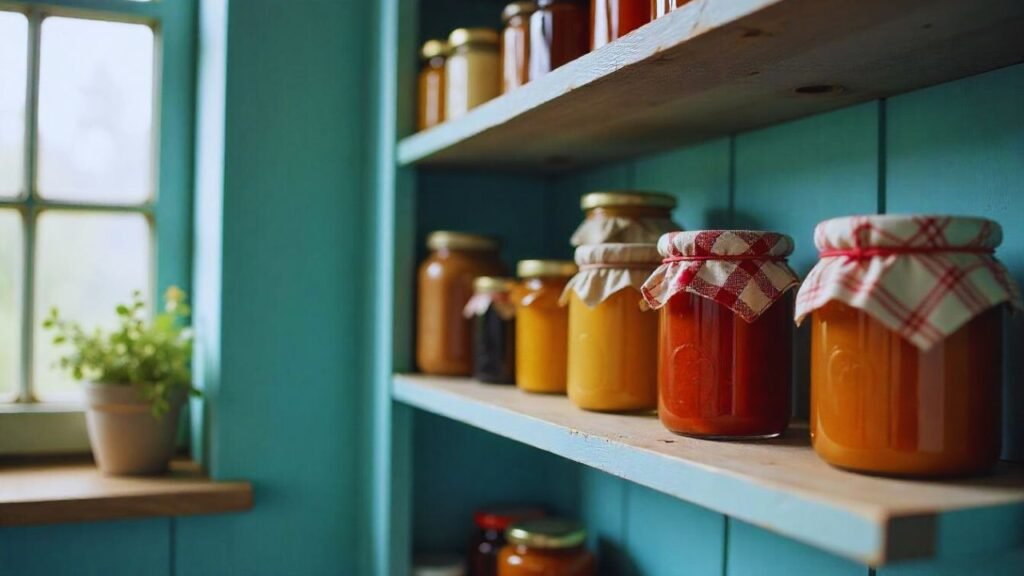
Choosing the best paint for pantry shelves comes down to prioritizing durability, cleanability, and a smooth finish, while also considering factors like VOCs and ease of application.
Here’s a quick summary of what the best paint for pantry shelves:
For Maximum Durability and Smoothness: Hybrid alkyd enamels like Benjamin Moore Advance or BEHR Urethane Alkyd Semi-Gloss Enamel are your top contenders. They offer the hardness of oil with the cleanup of water.
For Excellent Performance in Latex: HGTV HOME by Sherwin-Williams Infinity is a strong latex option known for stain resistance and coverage.
For Value and Durability: BEHR Premium Plus provides solid performance for homeowners on a budget.
For Low Odor and VOCs: HGTV HOME by Sherwin-Williams Ovation Plus is a good choice, claiming zero VOCs.
For Specific Needs:
- Laminate shelves: Absolutely, use an oil-based shellac primer like Zinsser BIN.
- Raw wood/MDF shelves: Again, an oil-based primer is crucial to seal the wood and prevent grain raising or tannin bleed-through.
- Finish: Semi-gloss is the recommended sheen for its durability and ease of cleaning.
Remember, the best paint to use for pantry shelves isn’t just about the can; it’s about the entire process, from meticulous preparation to proper application and allowing adequate cure time.
FAQs: Your Pantry Painting Questions Answered
What makes paint food-safe, and do I need it for my home pantry shelves?
Food-safe paints are specifically formulated to be non-toxic and resistant to bacteria, preventing them from leaching harmful substances or allowing microbial growth in food handling areas. They are designed for demanding environments like food factories, commercial kitchens, and processing plants, capable of withstanding steam, grease, and chemical cleaning. For a typical home pantry, a durable, fully cured cabinet paint (like the ones discussed) is generally sufficient, as direct, prolonged contact with unpackaged food is usually minimal. Always check the manufacturer’s technical data sheets for specific certifications if direct food contact is a concern.
Can I use paint designed for walls on my pantry shelves?
It’s strongly advised against using standard wall paint (like flat or regular emulsion) on pantry shelves. Wall paints are typically less durable and harder to clean than paints formulated for high-touch surfaces like cabinets or trim. They are prone to scuffing, scratching, and will show dirt and stains much more readily. For pantry shelves, you need a paint with high durability, good scrub-resistance, and an easy-to-clean finish like semi-gloss or a cabinet-specific enamel.
How long does the paint need to dry and cure before I can put items back on the shelves?
There’s a critical difference between “dry to the touch” and “fully cured.” While many paints might be dry to the touch in a few hours (e.g., BEHR Marquee in one hour), they need significantly more time to fully harden and reach their maximum durability. For cabinet paints like Benjamin Moore Advance, this can be 16 hours minimum between coats, and weeks to even months for a full cure. Experts recommend giving shelves ample time to cure, ideally several days to a week before placing heavy items or sliding things around, and being extra careful for the first few weeks. Rushing the cure time can lead to paint sticking or peeling.
Do I really need to sand if I’m using a self-priming paint or a deglosser?
While some deglossers or self-priming paints claim to provide adhesion without traditional sanding, most experts still recommend at least a light scuff sanding for optimal adhesion, especially on smooth or glossy surfaces. Sanding creates microscopic scratches that give the primer a better “grip.” If you opt for a liquid deglosser instead of sanding, ensure it’s applied correctly and allowed to work effectively. Even with self-priming paints, two coats are often recommended for pantry cabinets, as they receive heavy use. Always clean thoroughly after any sanding or deglossing to remove dust and debris.
Can I paint my pantry shelves white if the pantry is dark and enclosed? Will it yellow?
Painting pantry shelves white is a popular choice because it helps brighten dark, enclosed spaces by reflecting light. However, some oil-based paints, especially gloss finishes, have a known tendency to yellow over time, particularly in areas with limited UV exposure, like closets and pantries. If you choose white for a dark pantry, consider a high-quality water-based or hybrid alkyd enamel specifically designed for cabinets, as these are less prone to yellowing compared to traditional oil-based paints. Benjamin Moore Advance, despite its overall quality, has been noted by some users to yellow in unexposed areas.
What’s the best way to clean my painted pantry shelves after they’re done?
Once your shelves are fully cured, cleaning is quite straightforward, especially with a semi-gloss finish. The glossy surface repels dirt and stains effectively. You can typically clean them with a soft cloth or sponge and plain water, or a mild all-purpose cleaner. Avoid abrasive scrubbers or harsh chemical cleaners, as these can dull or damage the finish over time, even on durable paints. The semi-gloss finish makes it “easy to sponge-clean without the risk of dulling”.
Can I use chalk paint or mineral paint on my pantry shelves?
While chalk paint and mineral paint are popular for furniture upcycling due to their good adhesion and often no-sanding-required application, they are generally not recommended for high-wear areas like pantry shelves, especially for kitchen cabinets. These paints often require a topcoat to seal, which adds steps, and they typically dry to a more matte finish, which is less durable and cleanable for surfaces that see a lot of action. Additionally, they don’t block tannins from wood as effectively as oil-based primers, potentially leading to bleed-through with lighter colors. For the durability and cleanability needed for pantry shelves, a high-quality enamel paint is a better choice.
Conclusion: Transform Your Pantry, Transform Your Kitchen
Who knew so much thought could go into painting a few shelves? But as we’ve explored, selecting the best paint for pantry shelves is a critical decision that impacts not just the look but also the longevity and functionality of your refreshed space. It’s about empowering your pantry to withstand the daily chaos of a busy kitchen while looking effortlessly chic.
By understanding the differences between water-based, oil-based, and hybrid paints, prioritizing features like durability and cleanability, and committing to meticulous preparation, you’re well on your way to a pantry that feels brand new. Whether you opt for the professional-favorite Benjamin Moore Advance, the value-packed BEHR Urethane Alkyd, or a reliable Sherwin-Williams latex, the secret ingredient is always a solid foundation and a commitment to quality.
So, go forth, brave DIYer! With the right knowledge and the perfect paint, you can give your pantry shelves the facelift they deserve, turning a once-overlooked corner into a sparkling, organized, and truly functional heart of your home. Your spices (and your sanity!) will thank you. Now, if you’ll excuse me, I think I hear a snack calling my name from a perfectly painted shelf!
